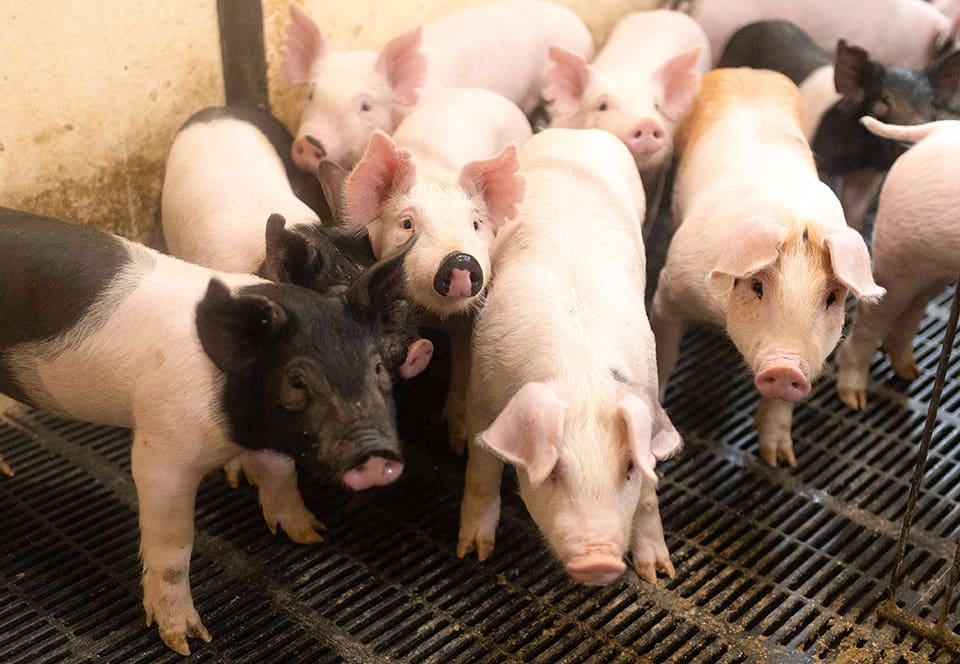
(Photo: Iowa Soybean Association / Joclyn Bushman)
Pork’s play in the meat case
February 15, 2024 | Bethany Baratta
Bite-sized tenderloin nuggets—available breaded or fresh. Pork wings—ready for the air fryer or oven preparation. Hungry yet?
Iowa pig farmers say they’re hungry for product innovation. At the Iowa Pork Congress held last month in Des Moines, farmers made note of evolving consumer preferences and urged the National Pork Board—its national checkoff affiliation—to dig into new products that will appeal to consumers while also expanding pork’s footprint in the fresh and frozen retail space.
“We have a great product, we just have to package it in a way that’s convenient for consumers,” says Trish Cook, the immediate IPPA past president from Winthrop. “It’s intimidating to go buy a 10 lb. pork loin-what do you do with that? We need some product innovation.”
The breaded pork tenderloin is a regional favorite; there are social media groups and contests dedicated to finding the best ones, but how can the pork industry make it a national favorite?
“Domestic demand hasn’t changed a lot,” she notes. “If we can find some pork items that people can throw into their cart versus another meat option, it would be exciting.”
Create the products and let consumers choose the best that’s right for their family’s palate, agrees Matt Gent, the newly-installed IPPA president from Wellman.
“As producers, packers, retailers and processors, we have to think differently about how we sell the pig going forward,” he says. “We have changing consumers. They’re telling us the answer, we have to listen.”
Cook says it’s not just about feeding families, but consumers are also revealing an entertainment aspect to choosing pork cuts, preparing methods and how best to prepare the protein.
“Food’s not just about feeding our bodies, but it’s entertainment as well. There are a lot of possibilities,” she says.
It’s one thing to create new product options, but it’s another to have an atmosphere that’s conducive to producer and consumer choice, Gent and Cook say.
At a time of squeezing margins for pig farmers and higher inflation for consumers and farmers, pressure from those who are trying to squash agriculture isn’t friendly for either group.
Take Prop 12 and Massachusetts’ Act to Prevent Cruelty to Farm Animals (referred to as Question 3), for example.
The Massachusetts law “prohibits any farm owner or operator from knowingly confining any breeding pig, calf raised for veal, or egg-laying hen in a way that prevents the animal from lying down, standing up, fully extending its limbs, or turning around freely.” Exceptions to this confinement rule include temporary holding cells for transportation, fairs, medical research, veterinary exams and other purposes, according to National Hog Farmer.
Prop 12, which passed in 2018, specifically requires pork meat sold in California to come from breeding pigs that have been able to stand up, lie down, fully extend limbs and turn around freely, according to National Hog Farmer. Turning around freely means turning in a complete circle without any impediment, including a tether and without touching the side of an enclosure for another animal. The enclosure also must have 24 square feet of usable floorspace.
While Question 3 is similar to Prop 12—banning any uncooked whole pork meat sold in the state that does not meet specific sow housing requirements, regardless of where it was produced—Question 3 goes further, not allowing the transshipment of whole pork through the state, National Hog Farmer says. According to the National Pork Producers Council, this jeopardizes an estimated $2 billion worth of pork that moves through Massachusetts into neighboring New England states. It’s even more concerning to Gent as it impacts producers’ ability to choose what’s best for their pigs.
“It should be up to the producer and the consumer if they feel like that’s what they want,” Gent says, noting that niche pork producers might fetch higher prices from consumers who want to buy a specialty product. Prop 12 and Question 3, however, would mandate the change in pig barns and raise costs and prices for producers and consumers, limiting choices for both.
“To mandate it and say that the producer has to produce that and the consumer has to buy that even though not all consumers want to spend the extra money on the product … whether you care about that or not, now can’t afford proteins you want for your family. It’s not only telling the producer what to do, it’s telling the consumer what to do. That’s not the American way if you ask me.”
Cook says state ballot initiatives are a slippery slope and put U.S. farmers and ranchers in precarious business positions.
“Some of the most frustrating things are state ballot initiatives put forth rules that are not science-based and put out by folks that want to have a meat-free society. They’re putting rules out to make raising pigs so hard that nobody wants to do it or so expensive that doesn’t work for the farmer,” Cook says. “I like to remind people that it’s not just about pork. Some state might say they only want grains that were raised with electric tractors or without bioengineered seeds. It’s bigger than pork, but we’re the only ones out there talking about it.”
Despite profitability concerns, Gent, an Iowa Soybean Association (ISA) member and a third-generation pork producer, says he’s optimistic about the state’s pork industry.
“I’m optimistic about the pork industry in general. We are still one of the cheapest forms of protein available to the consumer,” Gent says. “I feel like long term, how can that not be a good thing? In the economic point the world is in, at some point someone is going to say, ‘that’s too expensive, I’m going to buy this because it’s what I can afford and kids will still get protein.’ I don’t see how there won’t be demand for pork someday. Is it changing? Absolutely. We need more product innovation.”
Back